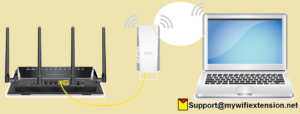Are you facing any kind of trouble in order to connect 2.4 GHz devices to the 5 GHz network? Would you like to learn how to connect 2.4 GHz devices to the 5 GHz network? You’ve come to the right place. You’ll learn about network bands, their differences, and how to connect to them in this section.
A 2.4 GHz WiFi spectrum is required for many smart home devices to function. The obvious answer is that these gadgets do not require a large amount of bandwidth to function. The reduced bandwidth is adequate. Aside from that, a 2.4 GHz WiFi band offers a greater coverage range, which is necessary for smart devices such as security cameras, smart lighting systems, and vacuum cleaners.
What is the difference between 2.4 GHz and 5 GHz?
We’ll start by explaining how the 2.4 GHz frequency band differs from the 5 GHz frequency band. The table below will help you understand the key differences between the two WiFi bands:
2.4 GHz
- The 2.4 GHz WiFi speed is slower than the 5 GHz WiFi speed.
- Low bandwidth.
- This band has a wider coverage range.
- It is a significantly congested band since it is used by more than one kind of device.
- Better at penetrating solid objects such as walls and floors.
- There are fewer wireless channels (just 11).
- WiFi interference is a problem.
5 GHz
- A 5 GHz WiFi connection is faster than a 2.4 GHz WiFi connection.
- increased bandwidth
- The coverage area is relatively small.
- When compared to 2.4 GHz, this band is less congested and is used by fewer devices.
- Solid objects are difficult to penetrate.
- There are more wireless channels (23).
- WiFi interference is kept to a minimum.
How Do You Connect 2.4 GHz devices to the 5 GHz Network?
Almost all new WiFi routers are dual band, meaning they support both WiFi bands. If you have a WiFi router with a 5 GHz band, you should be aware that it also supports a 2.4 GHz spectrum by default. Now we’ll show you how to connect 2.4 GHz devices to the 5 GHz network.
Some smart gadgets function on the 5 GHz spectrum, although the majority of these devices must connect to the 2.4 GHz band alone. They may connect to the higher band but will not function. You must only connect to the required band. To connect 2.4 GHz devices to the 5 GHz network, follow the steps outlined below.
Option 1: Enable the 2.4 GHz Wireless Radio
You can activate your WiFi router’s 2.4 GHz wireless radio. The router will only transmit over a 2.4 GHz network. Connecting your smart gadgets is as simple as connecting your phone or PC to the lower band. If the smart device can be managed via an app, use the app on your phone or the web interface on your PC to connect the smart device to the relevant WiFi band.
Option 2: Assign Different SSIDs to Each WiFi Band
Many WiFi routers allow you to specify different network names (SSIDs) to each wireless band. We recommend that you change the SSIDs right away. Change the network names for both bands in your router’s settings. Make sure to include a name so that you can tell them apart. You can now link your smart gadgets to the 2.4 GHz spectrum.
Can’t a WiFi router have separate SSIDs for each band?
It is possible that your WiFi router does not allow you to assign separate names to each WiFi band. In that case, you can permanently enable the 2.4 GHz band. But what if other household devices require a 5 GHz network? Higher frequencies are required for mobile phones, laptops, and desktops that require faster WiFi rates. In such instances, a wireless range extender can be used.
Option 3: Install a Dual Band WiFi extender.
A WiFi extender is a gadget that extends the current coverage range. The extension receives its input signals from the home’s root router. The WiFi signals are then stretched further to extend the router’s range.
What you can do is get a dual band extender, such as a Netgear WiFi extender. Install it through the mywifiext setup page. Set it to broaden the 2.4 GHz WiFi spectrum and connect smart gadgets that require this frequency to function. While all other devices in the house can continue to connect to the router transmitting at the 5 GHz frequency. By doing so yo will be able to connect 2.4 GHz devices to the 5 GHz network.
Netgear WiFi extenders can also have two distinct network names for each wireless band. If you feel the necessity, you can utilize both bands after finishing up the Netgear wifi range extender setup.
Conclusion
That’s all there is to it when it comes to connect 2.4 GHz devices to the 5 GHz network in your house. You can use any of the suggestions in this post to link smart gadgets or other devices that require a 2.4 GHz frequency spectrum to function. In case you are still not able to connect 2.4 GHz devices to the 5 GHz network, just dial our toll free number for free assistance from one of our experts.
For more information about:
How to Fix WiFi Connected But No Internet on Mac OS Device Issue
How to fix No Internet on Netgear WiFi extender With external antenna



